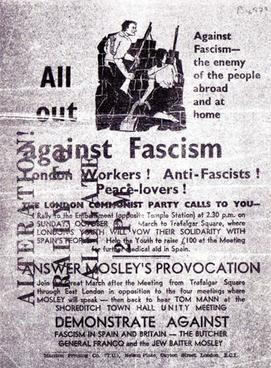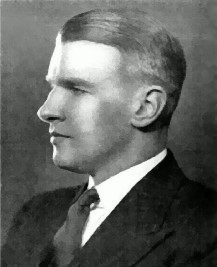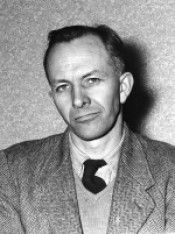Related Research Articles

Sir Oswald Ernald Mosley, 6th Baronet was a British politician during the 1920s and 1930s who rose to fame when, having become disillusioned with mainstream politics, he turned to fascism. He was a member of parliament and later founded and led the British Union of Fascists (BUF).

The Battle of Cable Street was a series of clashes that took place at several locations in the inner East End, most notably Cable Street, on Sunday 4 October 1936. It was a clash between the Metropolitan Police, sent to protect a march by members of the British Union of Fascists led by Oswald Mosley, and various de jure and de facto anti-fascist demonstrators, including local trade unionists, communists, anarchists, British Jews, supported in particular by Irish workers, and socialist groups. The anti-fascist counter-demonstration included both organised and unaffiliated participants.

The British Union of Fascists (BUF) was a British fascist political party formed in 1932 by Oswald Mosley. Mosley changed its name to the British Union of Fascists and National Socialists in 1936 and, in 1937, to the British Union. In 1939, following the start of the Second World War, the party was proscribed by the British government and in 1940 it was disbanded.

The Imperial Fascist League (IFL) was a British fascist political movement founded by Arnold Leese in 1929 after he broke away from the British Fascists. It included a blackshirted paramilitary arm called the Fascists Legion, modelled after the Italian Fascists. The group espoused antisemitism and the dominance of the 'Aryan race' in a 'Racial Fascist Corporate State', especially after Leese met Nazi Party propagandist Julius Streicher, the virulently racist publisher of Der Stürmer; the group later indirectly received funding from the Nazis. Although it had only between 150 and 500 members at maximum, its public profile was higher than its membership numbers would indicate.

The Flash and Circle is a fascist symbol used by several organisations. It was first used by the British Union of Fascists (BUF), and was adopted in 1935.

Rotha Beryl Lintorn Lintorn-Orman was the founder of the British Fascisti, the first avowedly fascist movement to appear in British politics.
Thomas P. Moran was a leading member of the British Union of Fascists and a close associate of Oswald Mosley. Initially a miner, Moran later became a qualified engineer. He joined the Royal Air Force at 17 and later served in the Royal Naval Reserve as an engine room artificer.
Alexander Raven Thomson, usually referred to as Raven, was a Scottish politician and philosopher. He joined the British Union of Fascists in 1933 and remained a follower of Oswald Mosley for the rest of his life. Thomson was considered to be the party's chief ideologue and has been described as the "Alfred Rosenberg of British fascism".
British fascism is the form of fascism which is promoted by some political parties and movements in the United Kingdom. It is based on British ultranationalism and imperialism and had aspects of Italian fascism and Nazism both before and after World War II.
Neil Lanfear Maclean Francis Hawkins was a British writer and politician who was a leading proponent of British fascism in the United Kingdom both before and after the Second World War. He played a leading role in the British Union of Fascists and controlled the organisational structure of the movement.

The Battle of Stockton, took place on 10 September 1933 at the Market Cross in the High Street of Stockton-on-Tees, County Durham, England. It was a clash between members of the British Union of Fascists (BUF) and anti-fascist demonstrators from the small local Communist Party and National Unemployed Workers Movement. The demonstration was an early attempt by the BUF to raise support in the area, but the Communist Party drove them out.

James Larratt Battersby was a British fascist and pacifist, and a member of the Battersby family of hatmakers of Stockport, Greater Manchester, England. He was forced to retire from the family firm due to his politics and was interned by the British government during the Second World War along with other British fascists. During his detention he came to believe that Adolf Hitler was Christ returned, and after the war wrote The Holy Book and Testament of Adolf Hitler. He committed suicide by leaping into the paddle wheels of a ferry.
Action was a newspaper of Oswald Mosley's British Union of Fascists (BUF). The paper first appeared in 1936. The editor of the paper from 1939 was Alexander Raven Thomson, the BUF's chief ideologue. It ceased publication in 1940 due to the outbreak of the Second World War and the internment of the BUF's leadership. In fact the British government banned the paper. For most of its existence, Action ran parallel to the official mouthpiece of the BUF, The Blackshirt. After the launch of the less hard-line and more intellectual Action, The Blackshirt became more low-brow and finally ceased publication in 1939.

Robert Row (1915–1999) was an English fascist from Lancaster, a member of Oswald Mosley's British Union of Fascists (BUF) who was detained by the British government under Defence Regulation 18B during the Second World War. After the war, he wrote and edited British fascist publications and remained a believer in Mosley until his death.
The Battle of South Street was a riot that took place on 9 October 1934 in Worthing, Sussex, England. The riot took place as members of the British Union of Fascists and various anti-fascist protesters clashed following a meeting of Fascists at the Pier Pavilion. The riot involved a series of clashes along and close to the length of South Street from the Pier Pavilion and the Royal Arcade at its southern end to the junctions with Warwick Street and Market Street further north.
The Fascist Defence Force (FDF) was the paramilitary section of the British Union of Fascists (BUF).

Charles Frederick Watts was a member of the British Union of Fascists who was interned during the Second World War.
The Battle of De Winton Field was a clash between the British Union of Fascists and various anti-fascist demonstrators that took place in Tonypandy, Wales, on 11 June 1936. It was the BUF's last attempt to hold a rally in Wales.
The Battle of Carfax (1936) was a violent skirmish in the city of Oxford between the British Union of Fascists (BUF) and local anti-fascists, trade unionists, and supporters of the Labour Party and the Communist Party of Great Britain. The battle took place inside Oxford's Carfax Assembly Rooms, a once popular meeting hall owned by Oxford City Council which was used for public events and located on Cornmarket Street.
References
- ↑ The Blackshirt. British Online Archives. Retrieved 14 November 2015.